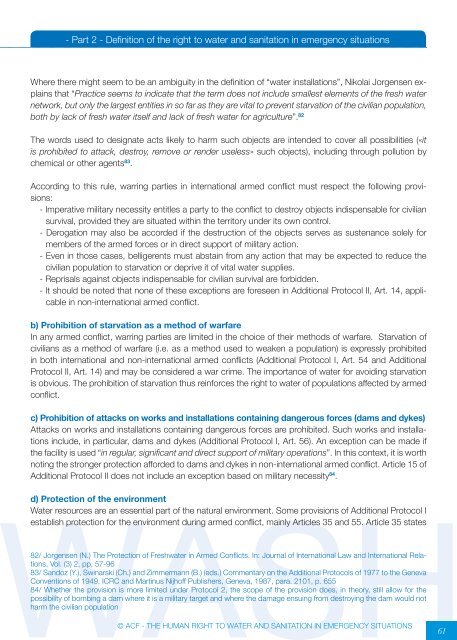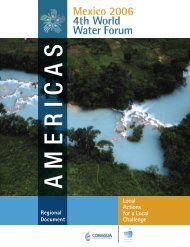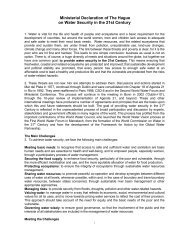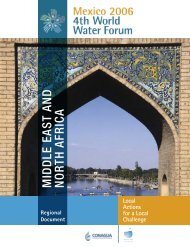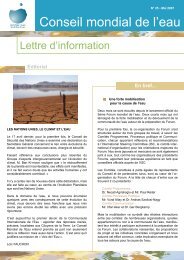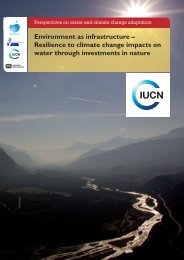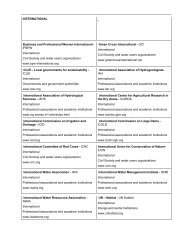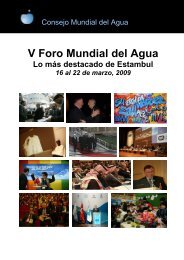the human right to water and sanitation in emergency situations
the human right to water and sanitation in emergency situations
the human right to water and sanitation in emergency situations
Create successful ePaper yourself
Turn your PDF publications into a flip-book with our unique Google optimized e-Paper software.
- Part 2 - Def<strong>in</strong>ition of <strong>the</strong> <strong>right</strong> <strong>to</strong> <strong>water</strong> <strong>and</strong> <strong>sanitation</strong> <strong>in</strong> <strong>emergency</strong> <strong>situations</strong><br />
Where <strong>the</strong>re might seem <strong>to</strong> be an ambiguity <strong>in</strong> <strong>the</strong> def<strong>in</strong>ition of “<strong>water</strong> <strong>in</strong>stallations”, Nikolai Jorgensen expla<strong>in</strong>s<br />
that “Practice seems <strong>to</strong> <strong>in</strong>dicate that <strong>the</strong> term does not <strong>in</strong>clude smallest elements of <strong>the</strong> fresh <strong>water</strong><br />
network, but only <strong>the</strong> largest entities <strong>in</strong> so far as <strong>the</strong>y are vital <strong>to</strong> prevent starvation of <strong>the</strong> civilian population,<br />
both by lack of fresh <strong>water</strong> itself <strong>and</strong> lack of fresh <strong>water</strong> for agriculture”. 82<br />
The words used <strong>to</strong> designate acts likely <strong>to</strong> harm such objects are <strong>in</strong>tended <strong>to</strong> cover all possibilities («it<br />
is prohibited <strong>to</strong> attack, destroy, remove or render useless» such objects), <strong>in</strong>clud<strong>in</strong>g through pollution by<br />
chemical or o<strong>the</strong>r agents 83 .<br />
Accord<strong>in</strong>g <strong>to</strong> this rule, warr<strong>in</strong>g parties <strong>in</strong> <strong>in</strong>ternational armed conflict must respect <strong>the</strong> follow<strong>in</strong>g provisions:<br />
- Imperative military necessity entitles a party <strong>to</strong> <strong>the</strong> conflict <strong>to</strong> destroy objects <strong>in</strong>dispensable for civilian<br />
survival, provided <strong>the</strong>y are situated with<strong>in</strong> <strong>the</strong> terri<strong>to</strong>ry under its own control.<br />
- Derogation may also be accorded if <strong>the</strong> destruction of <strong>the</strong> objects serves as sustenance solely for<br />
members of <strong>the</strong> armed forces or <strong>in</strong> direct support of military action.<br />
- Even <strong>in</strong> those cases, belligerents must absta<strong>in</strong> from any action that may be expected <strong>to</strong> reduce <strong>the</strong><br />
civilian population <strong>to</strong> starvation or deprive it of vital <strong>water</strong> supplies.<br />
- Reprisals aga<strong>in</strong>st objects <strong>in</strong>dispensable for civilian survival are forbidden.<br />
- It should be noted that none of <strong>the</strong>se exceptions are foreseen <strong>in</strong> Additional Pro<strong>to</strong>col II, Art. 14, applicable<br />
<strong>in</strong> non-<strong>in</strong>ternational armed conflict.<br />
b) Prohibition of starvation as a method of warfare<br />
In any armed conflict, warr<strong>in</strong>g parties are limited <strong>in</strong> <strong>the</strong> choice of <strong>the</strong>ir methods of warfare. Starvation of<br />
civilians as a method of warfare (i.e. as a method used <strong>to</strong> weaken a population) is expressly prohibited<br />
<strong>in</strong> both <strong>in</strong>ternational <strong>and</strong> non-<strong>in</strong>ternational armed conflicts (Additional Pro<strong>to</strong>col I, Art. 54 <strong>and</strong> Additional<br />
Pro<strong>to</strong>col II, Art. 14) <strong>and</strong> may be considered a war crime. The importance of <strong>water</strong> for avoid<strong>in</strong>g starvation<br />
is obvious. The prohibition of starvation thus re<strong>in</strong>forces <strong>the</strong> <strong>right</strong> <strong>to</strong> <strong>water</strong> of populations affected by armed<br />
conflict.<br />
c) Prohibition of attacks on works <strong>and</strong> <strong>in</strong>stallations conta<strong>in</strong><strong>in</strong>g dangerous forces (dams <strong>and</strong> dykes)<br />
Attacks on works <strong>and</strong> <strong>in</strong>stallations conta<strong>in</strong><strong>in</strong>g dangerous forces are prohibited. Such works <strong>and</strong> <strong>in</strong>stallations<br />
<strong>in</strong>clude, <strong>in</strong> particular, dams <strong>and</strong> dykes (Additional Pro<strong>to</strong>col I, Art. 56). An exception can be made if<br />
<strong>the</strong> facility is used “<strong>in</strong> regular, significant <strong>and</strong> direct support of military operations”. In this context, it is worth<br />
not<strong>in</strong>g <strong>the</strong> stronger protection afforded <strong>to</strong> dams <strong>and</strong> dykes <strong>in</strong> non-<strong>in</strong>ternational armed conflict. Article 15 of<br />
Additional Pro<strong>to</strong>col II does not <strong>in</strong>clude an exception based on military necessity 84 .<br />
d) Protection of <strong>the</strong> environment<br />
Water resources are an essential part of <strong>the</strong> natural environment. Some provisions of Additional Pro<strong>to</strong>col I<br />
establish protection for <strong>the</strong> environment dur<strong>in</strong>g armed conflict, ma<strong>in</strong>ly Articles 35 <strong>and</strong> 55. Article 35 states<br />
82/ Jorgensen (N.) The Protection of Fresh<strong>water</strong> <strong>in</strong> Armed Conflicts. In: Journal of International Law <strong>and</strong> International Relations,<br />
Vol. (3) 2, pp. 57-96<br />
83/ S<strong>and</strong>oz (Y.), Sw<strong>in</strong>arski (Ch.) <strong>and</strong> Zimmermann (B.) (eds.) Commentary on <strong>the</strong> Additional Pro<strong>to</strong>cols of 1977 <strong>to</strong> <strong>the</strong> Geneva<br />
Conventions of 1949, ICRC <strong>and</strong> Mart<strong>in</strong>us Nijhoff Publishers, Geneva, 1987, para. 2101, p. 655<br />
84/ Whe<strong>the</strong>r <strong>the</strong> provision is more limited under Pro<strong>to</strong>col 2, <strong>the</strong> scope of <strong>the</strong> provision does, <strong>in</strong> <strong>the</strong>ory, still allow for <strong>the</strong><br />
possibility of bomb<strong>in</strong>g a dam where it is a military target <strong>and</strong> where <strong>the</strong> damage ensu<strong>in</strong>g from destroy<strong>in</strong>g <strong>the</strong> dam would not<br />
harm <strong>the</strong> civilian population<br />
© ACF - THE HUMAN RIGHT TO WATER AND SANITATION IN EMERGENCY SITUATIONS<br />
61


